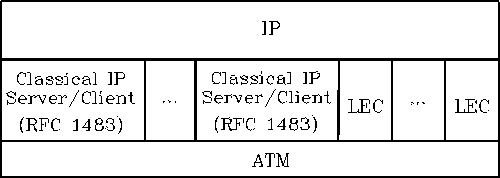

| Note: | See the glossary for definitions of the abbreviations and terms used in this chapter. This chapter describes the routing over native ATM. |
The routing overview presented in this section is short because the relationships between LAN Emulation (LE), Classical IP (CIP), and the supported routing protocols are simple. The router supports IP and IPX routing as illustrated in Figure 26 and Figure 27.
IP routing is supported between arbitrary combinations of Classical IP (CIP) and LAN emulation (LE) subnets, whereas IPX routing is supported over emulated LAN interfaces and RFC 1483 1 connections to other routers. These protocols treat emulated interfaces implemented by LAN emulation (LE) clients just like real Ethernet and Token-Ring interfaces. When an LE client is created, it is assigned a unique interface number.
RFC 1483 (Multiprotocol Encapsulation over ATM Adaptation Layer 5) provides the details about the encapsulation of bridged and router frames. Routing of IP and IPX traffic is supported. The software also provides the full range of bridging capabilities, allowing bridged traffic to be transmitted natively over ATM.
RFC 1483 specifies LLC/SNAP encapsulation for carrying multiprotocol traffic over ATM. A LLC value of 0xAA-AA-03 is specified to indicate the presence of a SNAP header. The OUI portion of the SNAP header is 0x00-00-00 for routed protocols, and 0x00-80-C2 for bridged protocols.
Classical IP uses the LLC/SNAP format for routed protocols defined in RFC 1483. The router also supports connections to IPX routers that use LLC/SNAP encapsulation. This IPX support is modeled after the Classical IP approach.
IPX routers use routing information protocol (RIP) and service advertising protocol (SAP) to propagate routing and device information tables. On LANs or emulated LANs, these protocols use broadcast frames to propagate information to interested parties. The router will also propagate the routing and device information to and from all RFC 1483 connections with other IPX routers.
Like other routers that support RFC 1483 LLC/SNAP encapsulation on ATM, the router can be interconnected in full or partial meshes using manually configured RFC 1483 connections.
In a fully meshed network, every router has a direct connection to every other router. In a partially meshed network, not every router has a direct connection to every other router; however, there exists enough connectivity for any router to reach any other router, directly or through another router. In the partially meshed network, some routers must perform intermediate routing. An intermediate router provides connectivity between routers that are not directly connected to one another.
Both permanent virtual circuits (PVCs) and configured switched virtual circuits (SVCs) are supported. However, virtual channel connections (VCCs) to IPX routers must be dedicated to IPX; they cannot be shared with other protocols, such as IP.
As with Classical IP, Quality of Service characteristics can be specified by configuring VCC traffic parameters such as Peak and Sustained Rates, and multiple circuits can be configured on a single ATM interface.
The router supports a single IPX network per ATM interface. This statement implies that there is a single ATM ARP client per interface for IPX, which must be explicitly configured. Therefore, all interconnected routers on the ATM interface must be part of the same IPX network.
IPX ATM addresses must be unique among all components using RFC 1483 encapsulation, including Classical IP components. The
end system identifier (ESI) and the selector portions of IPX ATM addresses are configured in the same manner as Classical IP ATM addresses. When the router does not initiate the SVC, then at least the selector should be explicitly specified in order to provide a fixed address that can be configured at the calling router.
IPX protocol addresses have two parts: a 4-byte network number and a 6-byte host number (or host ID). Network numbers must be unique within IPX routing domains, and host numbers must be unique within a given network. The router sets the IPX host number to the ESI component of the associated ATM address. Whenever you do not explicitly configure the ESI, it defaults to the MAC address that is burned into the ATM interface hardware.
You can specify destination IPX host numbers during VCC configuration or they can be learned dynamically using InATMARP. You must manually configure the IPX host numbers of destination routers that do not support InATMARP. The router also periodically uses InATMARP to refresh its knowledge of the partner router's IPX host number.
Routers that are interconnected in a partial mesh and are providing intermediate routing between routers on the same ATM interface should disable IPX split-horizon on the ATM interface. Doing this ensures that RIP and SAP correctly inform the interconnected routers of all available routes and services. Routers that are interconnected in a full mesh need not disable split-horizon.
The router implementation of RFC 1483 support for IPX routing requires minimal configuration. The IPX network number and the IPX host number (IPX ATM ARP client) are the only information that is required. If you wish to open a connection to a remote IPX router, you must additionally configure the desired virtual channel connections (VCCs). Although the combination of RFC 1483 encapsulation and InATMARP has not yet been standardized, the combination is specified for IPX over Frame Relay in RFC 1490/2427. 2